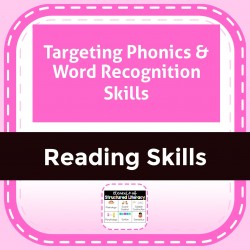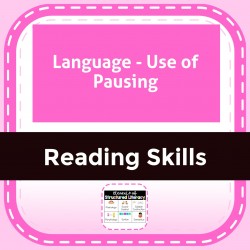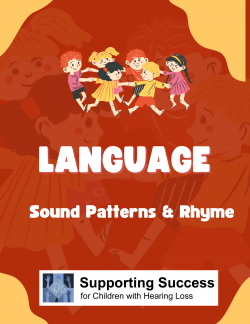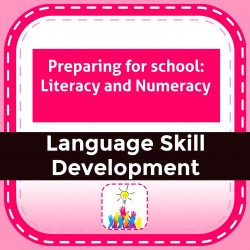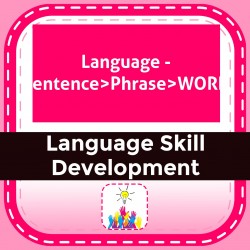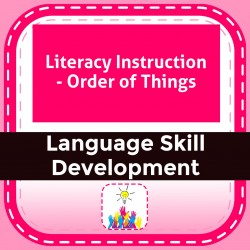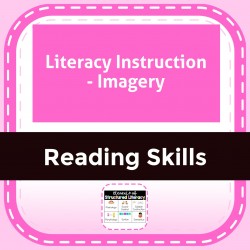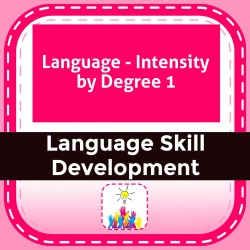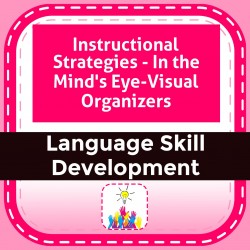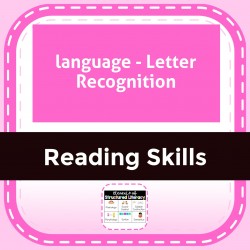Ability Levels
Categories
Resource Types
Age/Grade Range
CCSS
Anchor Standard
Speaking & Listening
Language
Reading
Targeting Phonics & Word Recognition Skills
$ 195
Support development of foundational reading skills with activities and materials to practice: 1) vowel perception in isolation and in words, phoneme blending and sound-letter association; 2) discrimin
...
ation of vowels in words, sorting long & short vowels.
Language - Use of Pausing
$ 195
In conversation, the use of pausing has several purposes. A speaker may pause and then emphasis the first word in a following phrase to specify meaning in the sentence. Instructional strategies includ
...
ed for basic, intermediate, and advanced readers. Ideas and activities include listening for key words; fluency practice; and progressive sentences.
Language-Sound Patterns & Rhyme
$ 195
Sound patterns within words are used in oral and written language to create emphasis of thought and attention the rhythm and tone of language. Instructional strategies include ideas for teaching word
...
families, riddles, and word family sentences.
Preparing for school: Literacy and Numeracy
$ 6
Age-appropriate listening and language skills are required for any child to succeed at school. At school, more advanced developmental skills, namely literacy and numeracy skills, are developed. A pare
...
nt can already start to introduce basic literacy and numeracy concepts to a child as of birth. Parents do not always realize that preparing the child beforehand to learn each of these skills, is vital. Before children go to school, they need to acquire certain skills that will help them to read and write. This is the joint responsibility of the parents and the child’s educational team, such as the teacher of the deaf/hard of hearing, early intervention provider, speech-language therapist, and/or preschool teacher.Emergent literacy: Before teaching reading and writing skills, a child needs to know the processes and concepts involved in reading and writing. Emergent literacy skills discussed in this lesson include literacy socialization, phonological awareness, as well as printed word and alphabet knowledge. Reading is the process through which meaning is attached to written symbols and letters. It is about comprehending and actively responding to the content.Writing is the use of symbols to communicate thoughts and ideas. It is a way to represent language in a visual and tactile form. The development of the different components of emergent literacy, reading and writing is discussed in this lesson.
Language - Sentence>Phrase>WORD
$ 195
Words can be examined individually for meaning. Words can be changed by adding affixes. Words can be manipulated within a phrase or sentence. Word consciousness is the curiosity to recognize a new wor
...
d, find its meaning, and become comfortable using the word in speaking and writing. It is important to create a supportive ‘word learning’ environment at home and at school to increase this awareness and usage. Instructional strategies included for recognizing words, making word webs; word games; and word order. Activities for beginning, intermediate, and advanced readers.
Literacy Instruction - Order of Things
$ 195
Teacher information that supports sequential memory. Instructional strategies include suggestions for teaching ordering events, actions, and things for an active and competent sequential memory in stu
...
dents.
Literacy Instruction - Imagery
$ 195
Imagery is the creation of a representation of an idea or concept in the mind. These instructional strategies include ways to improve reading comprehension by using vocabulary knowledge and learning
...
to create mental images.
Language - Intensity by Degree 1
$ 195
Explains that intensity represents a change in complexity for any area of learning. Uses visualizing, rating scales, sequencing, and graphic organizers.
Instructional Strategies - In the Mind's Eye-Visual Organizers
$ 195
Nonlinguistic representation to support learning. Teach in ways to help students visually process information. Using graphic organizers, physical models, pictures, and kinesthetic activities. Include
...
s fillable forms and ideas for sensory activities. See BUNDLE at S0XTEA0815.
language - Letter Recognition
$ 195
Explains that learning letters supports reading and writing success. Includes instructional strategies and 3 worksheets. Great for emerging readers.
 Your browser is out of date. For best experience switch to latest updated Browser.
Your browser is out of date. For best experience switch to latest updated Browser.
 Get Chrome
Get Chrome Get Edge
Get Edge Get Firefox
Get Firefox